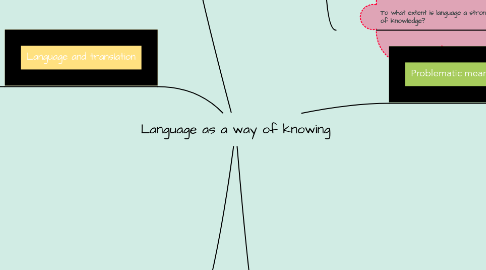
1. Language and translation
1.1. Different languages divide up the world in different ways.
1.1.1. That is why, learning a second language gives you a perspective on your own.
1.2. If you make a word-to-word translation, you will get a nonsense sentence.
1.2.1. Translation is more of an art than a science.
1.3. Problems of translation
1.3.1. Context: The meaning of a word has to do with the relationship it has with other words.
1.3.2. Untranslatable words.
1.3.3. Idioms: The meaning of an expression cannot be worked out from the meaning of the words it contains.
1.3.3.1. For example, "I was over the moon", or "Do not beat about the bush."
2. What is language?
2.1. Language is a complex phenomenon.
2.1.1. Language is rule-governed: Grammar and vocabulary state rules.
2.1.2. Language is intended: For body movements to be body language we have to intend communicating.
2.1.3. Language is creative and open-ended: We are able to create and understand sentences that have never been written or said before.
2.2. A great deal of our knowledge comes through language and this makes possible an intellectual division of labour.
2.3. How far language is unique and different for every human being?
2.4. To what extent is language a strong way of knowledge?
3. Labels and stereotypes
3.1. We cannot take the meanings of things for granted.
3.2. Language affects the way we think and the kinds of value-judgements that we make about things.
3.3. Labelling system.
3.3.1. Using labels is efficient and economical.
3.3.2. A good label enables to predict how the object in question will behave,
3.3.3. The most useful way of classifying luggage, for example, is likely to vary with context.
3.3.3.1. A designer, a baggage handler and a traveller classify it in different ways.
3.3.4. Labels are a social construct.
3.3.5. To what extent do our labels passively describe reality, and to what extent do they actively structure it?
3.4. Stereotypes
3.4.1. Labels can easily harden into stereotypes.
3.4.2. Stereotypes arisen when we make assumptions about someone or something.
3.5. To what extent does language generalize individual experience, classifying it within the experience of the group?
4. Problematic meaning
4.1. When we consider how language is used in practice, things start to get complicated.
4.1.1. Vagueness
4.1.1.1. Many words tend to be very vague and their meaning depends on context.
4.1.1.2. Even in a specific context, people may have different ideas of what a vague word implies.
4.1.1.3. Vague words are very useful as it is impossible to make words completely precise.
4.1.1.4. For example, some men are bolder than others, but it is impossible to say exactly where non-baldness ends and baldness begins.
4.1.2. Ambiguity
4.1.2.1. Ambiguity can be used to mislead people.
4.1.2.2. Persons like politicians can exploit an ambiguous sentence so that it is understood in different ways by different listeners.
4.1.2.3. For example, "I am opposed to taxes which damage incentives" Can be interpreted as "I am opposed to all taxes as they damage incentives" or "I am opposed to those taxes which damage incentives".
4.1.2.4. Context can help us to determine the meaning of an ambiguous sentence.
4.1.3. Secondary meaning
4.1.3.1. The denotation of a word is public, the connotation of a words varies from person to person
4.1.3.2. Words have also secondary meaning and connotation.
4.1.3.3. For example, the word "death" have different connotations. Sometimes we use the euphemism "passed away", for the word not to sound too harsh.
4.1.4. Metaphor
4.1.4.1. We use language not only literally but also metaphorically.
4.1.4.2. To identify the metaphorical or literal meaning of a sentence we have to take a look at their context.
4.1.4.3. For example, "Miranda has got her head in the clouds" does have a literal meaning. Miranda is not literally in the clouds, but she is in a dreamlike state.
4.1.5. Irony
4.1.5.1. It is found in all cultures.
4.1.5.2. It shows how problematic language in action can be.
4.1.5.3. For example, if the weather is extremely terrible, we might look at the window and say "Nice weather, eh?" This is clearly not true, however, it is obvious that the weather is bad. Therefore, the irony is going to be understood.
5. Language and thought
5.1. Sapir-Whorf hypothesis
5.1.1. The claim that the language you speak influences or determines the way you see the world.
5.1.2. The way we think can be described as a form of linguistic determinism.
5.1.2.1. The idea that our language and its structure limit and determine what and how we think.
5.1.3. Some people disagree this hypothesis as they say that the word someone may know does not affect their reality.
5.1.3.1. For example, the reason that there are not many words for "snow" in England, does not mean that in England it does not snow a lot.
5.1.3.2. How do the words we use to describe an idea affect our understanding of the world?
